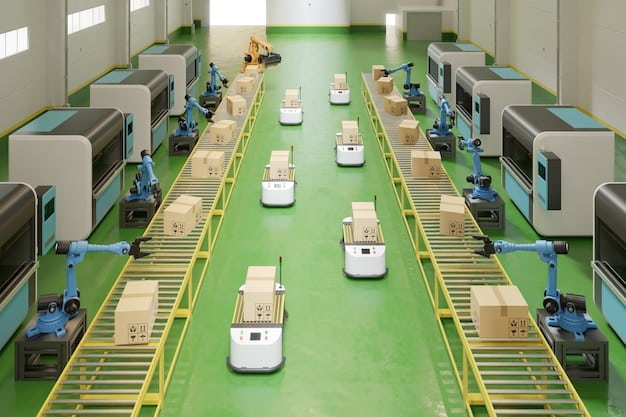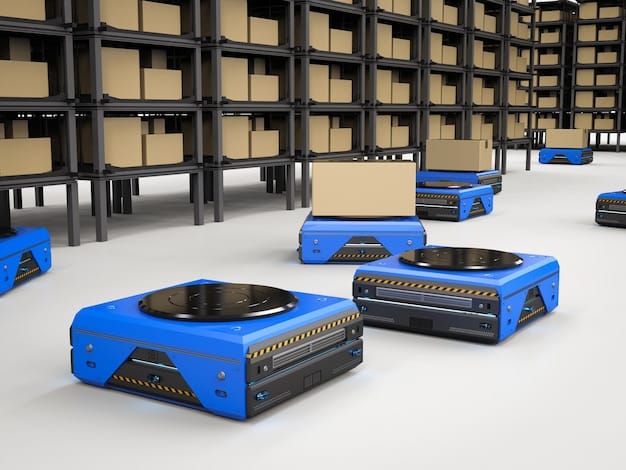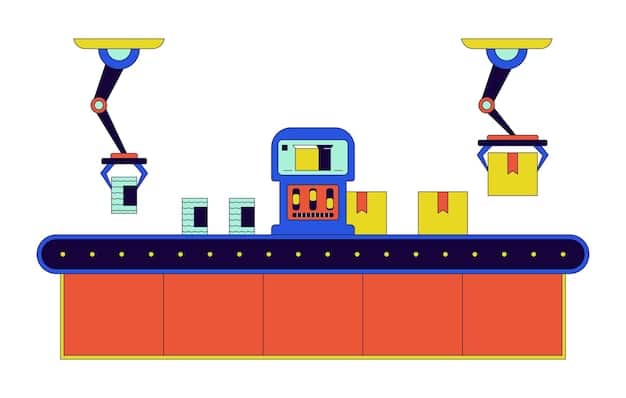Newest US Robotics Advancements for Warehouse Automation

The newest advancements in US robotics for warehouse automation include AI-powered robots, advanced autonomous mobile robots (AMRs), sophisticated picking and packing systems, and predictive analytics for optimized operations.
The landscape of warehouse automation in the United States is undergoing a rapid transformation, driven by groundbreaking advancements in robotics. These innovations are not just about replacing human labor but also about creating more efficient, safer, and smarter warehouse operations. Let’s delve into what are the newest advancements in US robotics for warehouse automation.
The Rise of AI-Powered Robots in Warehouses
Artificial intelligence (AI) has become a cornerstone in the evolution of warehouse robotics. AI-powered robots are capable of performing complex tasks that were previously exclusive to human workers. These robots leverage machine learning algorithms to adapt to dynamic environments and optimize their performance over time.
Enhanced Object Recognition
AI algorithms significantly enhance object recognition capabilities in robots. This allows them to identify and differentiate between various types of products, packaging, and even damaged items with unparalleled accuracy.
Real-Time Decision Making
AI empowers robots to make real-time decisions based on incoming data. They can adjust their routes, prioritize tasks, and even predict potential bottlenecks, leading to smoother and more efficient warehouse operations.
- Improved Navigation: AI-driven robots navigate complex warehouse layouts with ease, dynamically adjusting to obstacles and changes in the environment.
- Optimized Task Allocation: AI algorithms analyze real-time data to allocate tasks to robots based on their capabilities and current location, maximizing efficiency.
- Predictive Maintenance: AI can predict when a robot might need maintenance, reducing downtime and ensuring continuous operation.
The integration of AI into warehouse robots is not merely an upgrade; it’s a paradigm shift. These robots are becoming increasingly intelligent, autonomous, and capable of handling a wide range of tasks with minimal human intervention.

Autonomous Mobile Robots (AMRs) Take Center Stage
Autonomous Mobile Robots (AMRs) represent a significant leap forward compared to traditional Automated Guided Vehicles (AGVs). Unlike AGVs, which require pre-defined paths, AMRs can navigate warehouses dynamically using advanced sensors and mapping technology.
Flexibility and Scalability
AMRs offer unparalleled flexibility and scalability. They can be easily deployed in existing warehouses without the need for extensive infrastructure changes. Their ability to adapt to changing warehouse layouts makes them a versatile solution for businesses of all sizes.
Collaborative Functionality
AMRs are designed to work collaboratively with human workers, enhancing productivity and safety. They can handle repetitive and physically demanding tasks, freeing up human workers to focus on more complex and strategic activities.
- Dynamic Route Planning: AMRs use real-time data to plan their routes, avoiding obstacles and optimizing their path to the destination.
- Sensor Fusion: AMRs incorporate multiple sensors, including LiDAR, cameras, and ultrasonic sensors, to create a comprehensive understanding of their surroundings.
- Safety Features: AMRs are equipped with safety features such as emergency stops and obstacle avoidance systems to prevent accidents.
AMRs are revolutionizing warehouse logistics by offering a flexible, scalable, and collaborative solution that enhances efficiency and safety. Their ability to navigate complex environments and work alongside human workers makes them a key component of modern warehouse automation.
Sophisticated Picking and Packing Systems
Picking and packing are among the most labor-intensive processes in warehouses. Advancements in robotics have led to the development of sophisticated picking and packing systems that significantly reduce labor costs and improve order fulfillment accuracy.
Robotic Arms with Advanced Grippers
Robotic arms equipped with advanced grippers are capable of handling a wide variety of products, from delicate items to heavy packages. These grippers use sensors and AI algorithms to determine the optimal grip force and prevent damage to the products.
Automated Packing Machines
Automated packing machines streamline the packing process by automatically selecting the appropriate packaging material, folding boxes, and sealing them securely. These machines can significantly increase packing speed and reduce material waste.

The integration of robotic arms and automated packing machines transforms the picking and packing process into a highly efficient and accurate operation. This not only reduces labor costs but also improves customer satisfaction by ensuring faster and more reliable order fulfillment.
Predictive Analytics for Optimized Operations
Predictive analytics is playing an increasingly important role in optimizing warehouse operations. By analyzing historical data and real-time information, predictive analytics algorithms can forecast future demand, identify potential bottlenecks, and optimize resource allocation.
Demand Forecasting
Predictive analytics algorithms can accurately forecast future demand based on historical sales data, seasonal trends, and external factors such as marketing campaigns. This allows warehouses to optimize their inventory levels and ensure they have the right products in stock to meet customer demand.
Bottleneck Identification
Predictive analytics can identify potential bottlenecks in the warehouse operations, such as congestion in specific areas or delays in the picking process. This enables warehouse managers to take proactive measures to address these issues and prevent disruptions.
- Optimized Inventory Management: Predictive analytics helps warehouses optimize their inventory levels, reducing carrying costs and preventing stockouts.
- Efficient Resource Allocation: Predictive analytics enables warehouses to allocate resources more efficiently, ensuring that the right equipment and personnel are available when and where they are needed.
- Reduced Downtime: Predictive analytics can predict when equipment might need maintenance, reducing downtime and ensuring continuous operation.
Predictive analytics is transforming warehouse management by providing valuable insights that enable businesses to optimize their operations, reduce costs, and improve customer satisfaction. Its ability to forecast demand, identify bottlenecks, and optimize resource allocation makes it an indispensable tool for modern warehouses.
The Impact of 5G Technology on Warehouse Robotics
The emergence of 5G technology is poised to further accelerate the adoption of robotics in warehouses. 5G offers significantly faster speeds, lower latency, and greater bandwidth compared to previous generations of wireless technology, enabling new possibilities for warehouse automation.
Enhanced Connectivity and Communication
5G provides the enhanced connectivity and communication capabilities needed to support the deployment of large numbers of robots in warehouses. Its low latency enables real-time communication between robots, control systems, and human workers, ensuring seamless coordination and collaboration.
Real-Time Data Processing
5G’s high bandwidth allows for the transmission of large amounts of data from robots to central processing units in real-time. This enables more sophisticated AI algorithms to be used for tasks such as object recognition, navigation, and decision making.
The capabilities that 5G are offering are revolutionizing warehouse settings regarding the communication between computers and other machines, this is improving the automation in warehouses by providing better connection and communication capabilities.
Challenges and Opportunities in Robotics Deployment
While the advancements in warehouse robotics offer significant benefits, businesses also face a number of challenges when deploying these technologies. Overcoming these challenges is crucial for realizing the full potential of robotics in warehouse automation.
High Initial Investment Costs
The initial investment costs associated with deploying robotics can be substantial. Robots, software, and infrastructure upgrades can be a significant financial burden, particularly for small and medium-sized businesses.
Integration Complexity
Integrating robotics into existing warehouse operations can be complex and time-consuming. It requires careful planning, coordination, and expertise to ensure that the robots work seamlessly with the existing systems and processes.
- Workforce Training: Businesses need to invest in training programs to equip their workforce with the skills needed to operate and maintain the robots.
- Data Security: As robots collect and transmit large amounts of data, businesses need to implement robust security measures to protect against cyber threats.
Despite these challenges, the opportunities offered by robotics in warehouse automation are immense. By carefully planning their deployment strategy, addressing the integration complexities, and investing in workforce training, businesses can overcome these challenges and reap the rewards of increased efficiency, productivity, and safety.
| Key Point | Brief Description |
|---|---|
| 🤖 AI-Powered Robots | Enhance object recognition and enable real-time decision-making. |
| 🚚 Autonomous Mobile Robots | Offer flexibility and scalability, navigating warehouses dynamically. |
| 📦 Picking & Packing Systems | Robotic arms and automated machines reduce labor costs and improve accuracy. |
| 📊 Predictive Analytics | Forecast demand and optimize resource allocation for efficient operations. |
FAQ
▼
AI-powered robots enhance object recognition capabilities, enabling them to identify and differentiate between various types of products with high accuracy, improving sorting and handling efficiency.
▼
AMRs can navigate warehouses dynamically using sensors, while AGVs require pre-defined paths. This makes AMRs more flexible and scalable for adapting to changing warehouse layouts.
▼
Robotic arms equipped with advanced grippers can handle a wide variety of products and improve picking and packing accuracy, reducing labor costs and order fulfillment times.
▼
Predictive analytics algorithms forecast future demand, identify potential bottlenecks, and optimize resource allocation, enabling warehouses to streamline operations and improve customer satisfaction.
▼
5G technology enhances connectivity and communication, allowing for real-time data processing and improved coordination between robots and control systems, leading to seamless warehouse operations.
Conclusion
The newest advancements in US robotics for warehouse automation are revolutionizing the industry, driving efficiency, productivity, and safety to new heights. From AI-powered robots to sophisticated picking and packing systems, these innovations are transforming warehouses into smart, agile, and highly competitive operations, offering a glimpse into the future of logistics.





